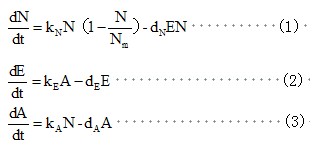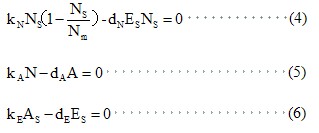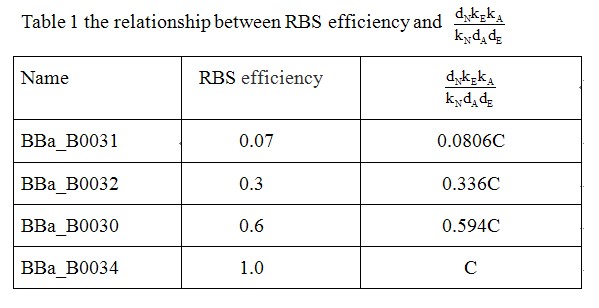Team:XMU-China/Model
From 2011.igem.org
Different RBS sequences lead to different levels of expression of the killer protein ccdB which is directly linked to the effects of our programmed cell-death circuit. So we constructed a series of circuits with different RBS sequences so as to detect how RBS of different efficiency can affect the viable cell density at steady state. We build a model to search for a theory to predict growth rule of bacteria with the programmed cell-death circuit.
We assume that:(1) without the circuit,changes in viable cell density(N,/ml)follow logistic kinetics;(2)for population-circuit growth, the cell death rate is proportional to the intracellular concentration of the kill protein(E, nM) ;(3)the production rate of E is proportional to AHL concentration(A, nM) ; (4)AHL production rate is proportional to N;(5)degradation of the kill protein and AHL follows first-order kinetics.

are the rate constants(/h).

is the carrying capacity in the Limited medium without the cell-death circuit.
At steady state, we can get the following equations:

Where subscript ‘s’ represents steady state. There are two steady-state solutions:

We can get the following equation (9) from equation (8) .

With time limited, we only conducted the experiment on the viable cell density at steady-state with the population-control device with RBS0.07 ,RBS0.3, RBS0.6 and RBS1.0.
And we define that:

Computed from our experimental data, we can get the data listed in Table 1.

From the model and Table 1, we can conclude that: the efficiency of RBS (a) may have close relationship with kE . Based on the device of RBS1.0, the viable cell density at steady-state (NS ) of other devices with different efficiency of RBS can be shown as equation(10).

C is -4.96322E-09 in our experiment.
reference
[1]You L, Cox RS, Weiss R, Arnold FH. Programmed population control by cell-cell communication and regulated killing[J]. Nature, 2004, 428(6985): 868-871.
 "
"







